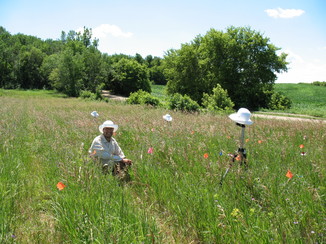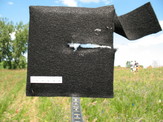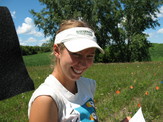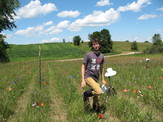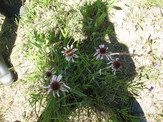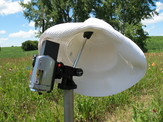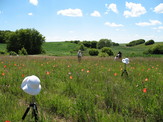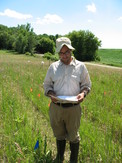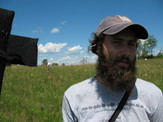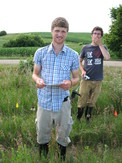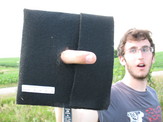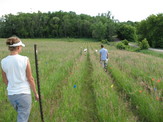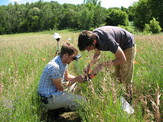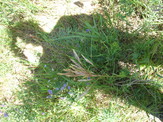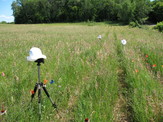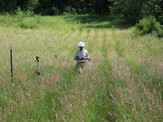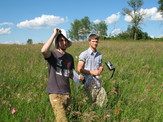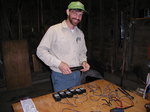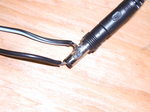|
|
Dear All,
This is Andy McCall, I am studying pollination and herbivory with Stuart and Ruth and am based, this summer, at Denison University, where I teach.
You may remember me through my witty or witless posts last year on this flog; it has been a long time since I have posted anything, but…
Together with Colin Venner (on the crew last year) and Monique Brown, both of Denison, I have cobbled together a few small videos of pollinators we observed last year. We have over 800h of video to watch and we are more than halfway done!
Anyway, I am going to try and post a few videos of known pollinators and a few unknowns — I would love it if anyone might be able to identify the unknown bee — we have several, but it is hard sometimes to see characteristics on the video.
I hope the flowering commences soon!
yours, Andy
A protocol for Team Video is in the early stages, and there are many aspects to consider. While it started slow, we have found a relatively quick and efficient system for placing cameras, taking down and storing cameras, and uploading videos. Unfortunately, many additional challenges await.
Watching the 2+ terabytes of footage will be a long and arduous task, and it is therefore key to plan well in these early stages. I believe the most important questions to ask at this phase are:
What data are we looking to collect?
With so much footage we have captured a lot of different things that we could potentially measure. We can see thrips on nearly every head we’ve recorded. We also have seen many ants, though typically of only two main species. Previous hypotheses about the roles of these ants have been posted, and the videos of the flowering heads would be a great resource for anyone wanting to find out more about them. As of now (though I’m not entirely sure as I haven’t thoroughly consulted with the rest of Team Video) I believe we are only going to record information about the insects that visit the heads and not their permanent residents.
What is the most effective/efficient way to collect these data?
This project cannot be done quickly or easily. Every day that we record in the Common Garden we get about 7-9 hours of footage per camera. With ten cameras rolling that is 70-90 hours of footage to watch per day. If we record for 5 days in a week (not uncommon) we then have 350-450 hours. That’s a freakin’ lot of video! Efficiency is key, but as a wise man once said “We’re looking to increase efficiency without losing accuracy”.
It is at these questions that I hit a wall, and would appreciate the input of my fellow bloggers/fans of the blog. As of now we have been using a video player that has the capacity to fast forward at speeds up to 32x, where should the line be drawn? At some point well below the 32x speeds, we might start missing things. Some bees only remain on the flower for a second or two before leaving, and the watcher of these videos may not catch these visits. However, there is really no way to watch these videos at normal speeds and expect to finish before the end of the decade (let alone the end of the summer). Also, a question directed at fellow Echinacea team members; are there data that you would like to be gathered from these movies that I haven’t mentioned? The ball has been passed into your court…
We forgot our list of what specific heads to video for each plant, so I decided, in the field, to just video the one with a twist tie color that comes first in the alphabet. I think we’ll use this method from now on as it is at least haphazard and it’s easy to remember.
Also, three of our rigged batteries failed immediately. I hope my big batteries from B and H come soon!
Video Andy
We have finished two weeks of the summer field season and I feel like we haven’t settled into a routine because we have been doing something new and different each day. It’s exciting.
Here’s a recap of accomplishments this past week…
Last week we finished searching for plants in the recruitment experiment. One plant (of ~1000 still alive) is flowering this year; it’s the first plant in the experiment to flower! The plant germinated in spring 2001.
Our high tech endeavors are underway and we have computer infrastructure to support them. Josh has networked the computers, hard drives, and printer. After some anxiety-inducing modifications to the video camera power supplies, we started taking video of pollinators & other visitors of Echinacea heads. Andy previewed a video this morning and it looks great! We still need to get more reliable power sources, but video cameras sure beat sitting on a bucket.
Colin has developed a camera rig to take shots of Echinacea heads in the common garden. We will be able to quantify many aspects of radial symmetry in the heads with the resulting digital images.
We assessed herbivory of ray florets in the common garden. We also looked at damage to disc florets. Jameson began to classify types of damage, but there weren’t that many heads with damage to the disk florets.
The KAP team (Julie, Rachel, and Josh) has made progress. Wind conditions have kept the kites on the ground most days, but they are making ground markers and have prepared the camera and rig. I flew the Sutton FlowForm 16 today in 12-16 mph surface winds at the park in Hoffman. Wow, it can pull. Yesterday, Gretel & I flew the G-Kites Dopero in somewhat variable winds. It was nervewracking.
The Bee team (Amy, Ian, Jameson, & Gretel) has abandoned my (bad) idea of watching bees through binoculars in favor of their much better idea. They are marking Agapostemon virescens individuals with acrylic paint and watching them when they are on the heads. They marked two bees on Friday and saw one on Saturday. Cool. They also have a slick form for entering observations.
We all have been making systematic observations of flowering phenology and style persistence of all plants in the common garden and along a transect at Staffanson Prairie Preserve.
In case anyone was wondering about the ostensibly narcissistic streak in recent posts, I _asked_ everyone on the team to post a profile with a photo.
Good work team Echinacea! We are making great progress in our quest to gain greater understanding of the ecology and evolution of plants and insects in fragmented prairie habitat.
Well, here are some pics from our night of terror in the barn.

Stuart about to void the warranty on the camcorders

Josh trying to hack the transformer

Closeup of soldering job
Well, I got to the farmhouse early to get ready for videorecording. Put the tripods in the big blue tubs for easy transport to the common garden, and then worked on getting random assignments of plants, which were kindly printed out by Stuart.
After assigning plants to different cameras, Colin and I walked briskly to the CG to set up everything. It took much longer than expected, partly because it was the first time and partly because I am really slow. I’m not sure why — I like to be careful and I have always been the slow one in the field, oh well.
One camera did not work after plugging in the doctored battery, so we pondered over it for quite a while. What was more alarming was that even the Sony-supplied battery stopped working in that particular recorder! I was worried at that point, so we tried another Sony battery and camcorder along with the doctored battery and the same horrible thing happened again — no recording and the original battery stopped working! So, we hightailed it back to the farmhouse to figure things out.
After trying different combos of batteries, doctored connectors, and such, we determined that one of the doctored batteries was to blame. Either it wasn’t charged enough, or maybe too much — I will have to check with the voltmeter to find out for sure. It was a relief to know that nothing was permanently damaged — I am nervous about this whole enterprise as it has been quite expensive! But, I am hoping that the data will be worth it.
Andy
I seem to have been shanghaid into this team, at least in a supporting role. Andy bought some sort of super-batteries, which seem to have a different connector than the Sony Handycam cameras he has. So he calls on me to solder connectors for them. Turns out, our hack job only works on the newer models of Handycam, though we’re working on getting the older ones to not throw up an error.
To get the newer ones working, we plug in the original battery, plug our hacked battery into the external power port, then remove the original battery. Doing it any other way makes the camera throw an error and not turn on fully.
Here is a draft for the video protocol. I’d love any useful comments you may have; it is definitely a work in progress, so if you read something and it isn’t clear, please let me know and I will change it. Thanks, A.M.
Protocol for recording pollinators:
v.1.0 (Jun 27 2007)
Equipment:
List of heads to video
A few (~5) pin flags
Five 3 x 5 in. cards and a sharpie
Set of camcorders and battery packs
A radio
1. Get a list of heads that need to recorded from Andy the evening prior to the actual recording date. Each person will be responsible for 3-4 heads for that recording day.
2. Get to the farmhouse at 8am sharp so that you can start recording for sure by 9am.
3. Make a list of ‘cue cards’ for each head that you are to record. This involves writing:
plant location (row and position), color of twist tie and date on a 3 x 5 in. card. This is the first thing you will ‘film’ when going out to the CG, so that we can match up videos to the correct file.
4. Go to each head on the list and make sure that it is still flowering. If not, then add another plant (we’ll supply > 5 heads per list), and make a note that the originally selected head is not flowering. If the plant IS flowering, then place a flag next to it so that you can find it easily. Go to the next head on the list.
5. Next, get the correct camcorder and battery (labeled A-J), put it on a tripod and put it in position over the inflorescence (head). The ideal distance is about 1 ft. away from the head with the camera zoom at about ½ max. zoom. You should be able to see the entire head; try to imagine identifying bees using your recorded image and adjust accordingly. Take a quick video of your ‘cue card’ for each head and then turn off the camera.
Set up all of your cameras first, before starting to record for pollinators. We want to start them all at the same time, so you will need to coordinate with other members of TEAM VIDEO to start synchronously (using your radios).
Make sure that there are no big branches, stems, twigs, etc. that could possibly wave in front of the camera, thus obscuring the inflorescence.
6. At more or less the same time, go to each camera and press the red ‘record’ button. Then, skedaddle away so that you don’t influence the pollinators!
7. At 4pm, go and stop each camera. Disconnect the batteries and return the camcorders and batteries to Andy. He’ll upload the video to a PC and re-charge the batteries for the next round of filming!
Trying to make sense of the batteries!
For the camcorders, the batteries themselves carry a charge of 7.2V and 4.9 Wh. But, the AC adapter’s output is 8.4V and 1.7A. Which to use? Perhaps the adapter is higher because there is some resistance in the cord going to the camcorder, but maybe I am just making that up.
Here is a link to a promising product, a 8.4V NiMh battery with a charger included! 40 bucks, though, so it would be $400 for all 10 cameras. Well, this may be worth it…would love your thoughts on this, SW.
There is a nice primer on choosing batteries here.
For our purposes, we can calculate battery capacity using the formula:
Ah = Watts x Time (h) you want to run the camera / voltage needed for the camera
So,
Ah = 3W x 8h / 7.2 V = roughly 3.3 Ah or 3300 mAh
Here’s a nice closeup of styles waving in the breeze and some shameless anthers shedding pollen:

|
|

